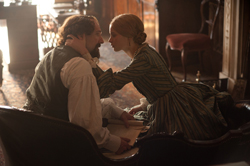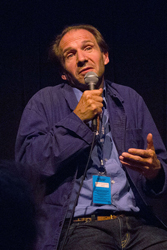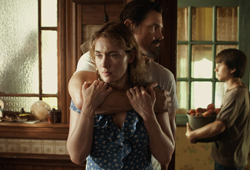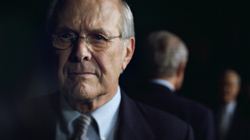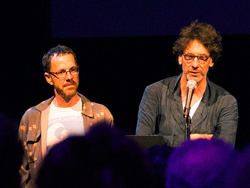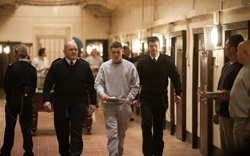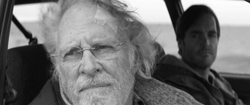This year marked the 40th year of the Telluride Film Festival and so an additional day was added to the schedule in celebration. Thus, the festival ran from Thursday through Labor Day rather than the usual Friday through Labor Day. Couple that with the addition of a huge new theater and you might expect that for once, you would get to see all the films you wanted to see. Fat chance. It was roughly the same as previous years where there were 3-4 movies that we really wished we could have seen, and many that we probably should have seen but had no hope of getting to.
In each of the last three years the winner of the Oscar for best picture had its debut at Telluride: “Argo”, “The Artist”, “The King’s Speech”. This year the likely contenders for that honor that debuted at Telluride are “All is Lost” and “12 Years a Slave”. Some others will be nominated in other categories I’m sure: “Labor Day”, “Prisoners”, “Tracks”, “Nebraska” and “The Invisible Woman” to start.
The festival sold out of passes earlier than it ever has, I checked in early July and some passes were still available but not for long after that. The new theater, named in honor of director Werner Herzog, spends most of the year as a hockey rink but for the festival is converted to a 650-seat theater. It wasn’t completed in time for the festival to sell additional passes, but they might do so in the future. All of this meant it was fairly easy to get into the movies we wanted to see, the constraints were simply time and endurance.
There are always some celebrities in attendance at Telluride and it’s pretty easy to find them and chat if desired. This year Ralph Fiennes (subject of a tribute) was out and about on the street. As was Michael Moore (attending just to see some movies it seems) and some guy who looked a lot like Quentin Tarantino. Brad Pitt was there to promote “12 Years a Slave” (Mr. Pitt plays a minor part and was a producer on the film) but if he was wandering around like the others, I didn’t see it. Joel and Ethan Coen were also at the festival as tributees.
Interestingly, Robert Redford, founder of the Sundance festival, debuted his new film (“All is Lost”) at Telluride and was also the subject of a tribute. Regrettably we couldn’t get to this one, by all reports it is a great film. Not sure why Telluride was chosen over Redford’s own Sundance for this premier. It might simply be a matter of timing, producers want to get a film shown as soon as it is ready. But there is a bit of competition between festivals too. Sony Pictures Classics was set to show “Philomena” but showed a documentary on JD Salinger so that the Toronto Film Festival would be able to claim that “Philomena” had its premier there.
Often there seems to be an unofficial theme to the movies at a festival and in this case it was “People who want to be together but can’t”. More in the reviews below but that theme was present in about seven or eight of the 17 movies that we saw. This was a good year for movies and I enjoyed and recommend almost all of them. Only a couple of the films followed the strict current Hollywood formula for movies while the rest ranged from ‘slice of life’ to impressionism – where the filmmaker was trying to impart a feeling more than a story. This can be a great formula for in-theater napping but I wasn’t too affected by that particular malady this year.
Here are the reviews, as always, festival photos by Secrets photographer Ray Keller.
12 Years a Slave
This is the clear Oscar contender from this year’s Telluride lineup. English director Steve McQueen has previously been at Telluride with his films “Hunger” and “Shame”. Both starred Michael Fassbinder. This one does as well but his role is likely to be defined as ‘supporting actor’ while Chiwetel Ejiofor’s portrayal of Solomon Northup will be promoted for best actor.
Solomon Northrup lived as a free man in upstate New York in the years before the Civil War. Not a slave, not a former slave, he was born a US citizen in Saratoga Springs, NY in 1808. In 1841 he was kidnapped and sold into slavery. He remained a slave, cut off from his family, for 12 years. Immediately upon re-gaining his freedom he wrote a book on his experience (“12 Years a Slave”) and toured and talked in support of abolitionism. His first-hand accounts of the horrors of slavery must have gone a long way towards building support for the cause in the North.
The movie deals only with the abduction and time that he was not free. The opening scene of Steven Spielberg’s “Amistad” might remain as one of the hardest slavery-related scenes to watch (sorry I haven’t seen “Django Unchained” yet) but this movie wins this notorious prize overall because the horror is revisited multiple times. In fact I found this movie the hardest to watch of any of the films this year because it is a document of history.
Other parts of this movie were so easy to watch I couldn’t pull my eyes away however. Steve McQueen and his director of photography, Sean Bobbitt, create some of the most beautiful pictures on the big screen. In “Hunger” they did it inside a prison, in “Shame”, on the gray streets of New York. In “12 Years a Slave” we finally have some nature shots and… wow. If I were a producer I would say ‘let’s take all of the nature footage we have and package it up as a separate DVD’.
Brad Pitt was at the screening. He’s a producer on the film and he has a small role. He’s not particularly impressive in his acting for this part but he’s extremely proud of the film in general and he should be.
The Invisible Woman
Ralph Fiennes was the subject of a tribute at this year’s festival and he brought a movie with him. This biopic tells a small part of the life story of Charles Dickens and a large part of the story of Nelly Ternan. Ternan was Dickens’ mistress and companion for the last 13 years of his life. Victorian society would not allow him a divorce from his wife or allow him to be seen with this young mistress so she had to remain a ‘kept woman’ and share in Dickens’ success only from the shadows.
Fiennes directs and plays Dickens, Felicity Jones plays Ternan and has the difficult task of conveying the inner, unexpressed pain imposed by this circumstance. She is up to it however and she makes the film worth watching. The clothes are another reason to watch, this will certainly be nominated for the best costume Oscar.
Under the Skin
This is one you will either love or hate. Most will hate it, I suspect. Those who like it will be Dr. Who-style science fiction fans. Scarlett Johansson will certainly attract some viewers as well.
The bar I use to judge science fiction films is lower than that for other films. Why? Look at the extensive process used to prepare the actors for the wrenching emotions of “The Past”. Or, even if that process isn’t used, consider the amount of personal history that goes into conceiving and writing “Labor Day”. Now, for this film, which actors or writers have experience being an alien sent to earth to harvest young men for consumption on another planet? Not too many, we hope (but you never know). And how do you prepare to act like an alien? What would be more alien-like? Besides, the director is probably too busy to rehearse his actors, he’s figuring out how to show technologies that don’t exist on Earth.
In “Under the Skin” the young men harvested (for a purpose we are not told but possibly just for food) are loners. They are chosen because they have no ties to family or even work so there won’t be a lot of people looking into what has happened to them. Ms. Johansson is the fisherman and the bait.
There are long stretches of this film with no dialogue, dreary Glasgow streets or Scottish wilderness and eerie music. Perfect! But, not for everyone.
Another fascinating aspect of this movie is that it was shot guerilla-style on the streets, and in one case in a dance club in Glasgow. When Scarlett Johansson falls face down on the sidewalk, the reactions of the people are real, they don’t know they are in a movie.
Labor Day
You might think a movie called “Labor Day” would be a shoe-in at a film festival held every year on Labor Day. But in this case I think it was the director, Jason Reitman (“Juno”, “Up in the Air”) which gave this movie the inside track. Not that it didn’t deserve to be shown. Based on the novel by Joyce Maynard, director Reitman wrote the screenplay adaption and said that it was likely the truest adaptation he will ever write.
Kate Winslet plays Adele, a lonely, agoraphobic single mother in a small town. A small town that happens to be near a prison. Josh Brolin is Frank, an escaped prisoner. That is probably all you need to know. The movie is heartwarming and touching to say the least.
There was some legitimate criticism from other festival-goers that Brolin’s character was an over-the-top too-perfect male. He cooks, he cleans, he fixes things around the house, he’s great with handicapped children. He makes pies for Chrissake! Back off, dude, you’re making the rest of us look bad. As Reitman said, he was as true to the novel as he could be in writing the adaptation. Novels, much more so than movies, can dwell on the interior lives of the characters. What are we to do then when a movie wants to be true to a novel that does so? Joyce Maynard herself in the comments about this book on Amazon.com says that one of the themes of the novel is “the sorrow and regret a woman feels when the dream of family life as she envisioned it has left her”. What does that look/feel like? What would the remedy look/feel like? The movie, like the novel, wants to convey the dream.
A different movie could add normal human complexity and imperfections to all the characters, and thereby take the edge off of what the author wanted to convey.
Not only Josh Brolin’s character but also his acting is over-the-top perfect in this movie. Kate Winslet is fantastic as always and she is my pick for a future tribute at Telluride.
Gravity
This film has a plot that is so simple, it too made me wonder about the nature of plot and story. You’re in space (especially if you see the 3D version – “you” are in space), somewhere over the horizon, a Russian satellite crashes with another and the resulting debris means that you and your space station are in deep doo-doo. Get yourself back to earth. That’s it. Thanks for playing.
In fact, the digital effects that make it look like Sandra Bullock is floating around the space station in zero gravity look more like a video game than anything else. I left thinking I had just watched a 90-minute commercial for the upcoming video game. In fact, I’m sure that’s what I saw.
And, if Josh Brolin is a too-perfect male in “Labor Day”, George Clooney is a too-perfect Clooney in “Gravity”. He plays the Cary Grant style glib astronaut accompanying Bullock in space. Not that there’s a lot of time to develop character when space debris is flying at you at 50,000 miles an hour.
So, you can’t fault this movie, it is what it is (a commercial), and it’s remarkable. It’s the best use of 3D ever. The shots of earth from space are worth the price of admission, no problem. If you really like it, you can buy the game and see if you can make it back to earth.
Burning Bush
This is a three-part series shown on the Czechoslovakian branch of HBO. It was a difficult film to choose because it required setting aside a four-hour block of time on this one film. The assumption was though, that it would not be showing on the US HBO, and maybe not even readily available on DVD. It is, however, a huge hit at festivals. The director and producers were moving on to London, Toronto and three festivals in India after Telluride, so it’s hard to imagine that there won’t be some chance to see it.
The Prague Spring event of 1968 was an attempt to regain some local control from the remote Soviet rule of Czechoslovakia. In response, the Soviets sent thousands of troops. Jan Palach was the first of two Czech students to set himself on fire in protest against this renewed Soviet occupation.
This historical drama begins with the self-immolation and then focuses mainly on the trial pitting Jan’s family against the Communist government, who wanted to downplay the incident. Dagmar Buresová, a young female lawyer, became part of his legacy by defending Jan’s family in the trial. The very fact that the trial was allowed to happen at all shows how the oppression was ‘soft oppression’. The government wanted it to look like people had rights, had a say, but in the end… not so much.
While this film has nowhere near the impact of “The Lives of Others”, in part because it doesn’t have the driving plot points of that film, it is well worth seeing both as a document of history and to see how the HBO (mini)series production values and techniques are being applied successfully halfway around the world. The director and lead actress received an extended standing ovation at our showing.
The Past
Writer-director Asghar Farhadi won the Best Foreign Film Oscar for “A Separation” which played at Telluride in 2011. That film, made inside Iran, not only transcended the constraints imposed by the cultural police of that country but actively incorporated them into a story with deep emotional resonance for anyone with a beating heart. “The Past” was made in France and goes even deeper into that deep, dark end of the pool. It’s about as deep as anyone would want to go.
The film was written by Farhadi while he was touring the world in support of “A Separation” and in a way picks up where that film left off. The final shot in “A Separation” shows us a couple on opposite sides of a glass security screen at an airport. Here we start with a different couple also with that partition, but in this case they are meeting, to finalize a divorce. From here the characters start to work their way towards that deep end, dragged inch by inch by the past, the children, feelings and other artifacts from previous relationships.
Bérénice Bejo, who you know as Peppy Miller in “The Artist”, here plays Marie, the female half of the couple. She is trying to move on to a new relationship. Ali Mosaffa is Ahmad, the husband, traveling to France (from Iran) to sign the papers for the divorce. The children, old and new, have the firmest grip on the way things used to be and they start the unraveling. This kind of emotional messiness is just like what we encounter, or run away from, in real life and that is what makes this film more scary and more moving than any other at the festival.
The process of making the film was rather extraordinary. Farhadi does not speak French and so not only did he have to work with a translator on the script itself, there was also a translator present on the set. Similar to the methods of director Mike Leigh, the work with the actors begins when the script is finished but the script is not revealed to them. Rather, over a two-month period the director works with the actors to develop the characters and let the actors come to what Farhadi has already written. The result is utterly brilliant on screen and almost makes me want to watch this film again. If I could take it.
Prisoners
Due to the strength of his 2010 film “Incendies”, Hollywood went to director Denis Villeneuve, giving him a choice of projects. He chose “Prisoners” on the strength of the script, even though he was ready to do something lighter. The script is so good you can see why he chose it.
“Incendies” has to do with war, and the underlying theme of children separated from their mothers, as both a cause and result of war. “Prisoners” deals with children separated from their mothers, and what parents might do in response to that. The setting in this case is dreary Pennsylvania at Thanksgiving.
In typical Hollywood style, this movie is heavy on tension and the heavyweight actors, Hugh Jackman and Jake Gyllenhaal primarily, have a lot to do with that. They are able to carry and convey the heavy emotions of a parent who has lost his daughter (Jackman) and the police officer responsible for finding her (Gyllenhaal), and their ability to do so will likely garner them Oscar nominations.
Also in Hollywood fashion it could be claimed that the movie is designed to make you think (What would you do? How far would you go?) but mostly you will just be exhausted from this movie. With so much budget, acting horsepower and movie-making ability, the medium exceeds the message in this case.
The Unknown Known
Want to watch Donald Rumsfeld stumble over his excessively explanatory way of saying “I don’t know”? Yes, the secretary himself is not sure what he really meant now when he said “There are known knowns, there are known unknowns, etc., etc.” Documentary film director Errol Morris made a very similar film, “The Fog of War”, using his unique and exhaustive interview style with Robert McNamara, who served as secretary of defense, with equal distinction, during the Viet Nam war. It was only natural to repeat the exercise with the Secretary who presided over the Iraq war, Donald Rumsfeld.
This film doesn’t quite live up to “The Fog of War”, only because the subject of that movie, Robert McNamara, remained a tortured soul from the Viet Nam war through the remainder of his life. Why did we let that war continue? How can I justify what I said to support that course of action? That bit of humanity near the center of such an inhumane action is something for us all to reach for and helps us to understand it all, perhaps. This Secretary of Defense, however, has no relatable components like that. He continues to insist that the action was right and that he never said: “insert just about anything he ever said here”. In the film he says that he never claimed that Iraq and Hussein had ties to 9/11, he never claimed that it was a certainty that Iraq had weapons of mass destruction, and he says that there was no evidence that policies that he was responsible for led to the torture perpetrated by US soldiers on Iraqis. Rumsfeld’s responses when confronted with the evidence that he was responsible, that he did say and write those things, range from an uncomfortable grin to attempting to redefine words to being appalled at the treatment doled out in our name, as if his memo that said to do exactly that didn’t exist.
In the Q&A after the film, Morris said that Rumsfeld remains a mystery and you have to wonder if this man is aware of the world around him. “Rumsfeld acts as if he can defeat reality through the redefinition of words.”
This old fossil has hung around politics since the stone age, in part because his method of talking a lot without saying much plays well in the press. This film may not be the equal of “The Fog of War” but that is not due to any fault of Morris’. I hope that everyone sees it. It constitutes, at last, the people’s chance to confront at least one of the people who perpetrated the Iraq war and all the horrors that went with it. “The World According to Dick Cheney” is a similar effort by documentary film maker RJ Cutler. I saw that film at the Sundance Festival earlier in the year and I recommend it for the same reasons. I was hoping that film would be available on DVD by now, but that is not yet the case.
Inside Llewyn Davis
Joel and Ethan Coen couldn’t make a bad movie if they tried. In this case, they themselves claimed that this movie is short on plot (so they added a cat) but with their usual humor (much of it provided by the great John Goodman) and love of music (as curated by T Bone Burnett), they have put together another winner.
In a relatively unknown musical period, the late ’50’s and early ’60’s, the folk music revival was prominent, especially in Greenwich Village in New York City. This was the period right before Bob Dylan. The memoir “The Mayor of MacDougal Street”, by musician Dave Van Ronk, planted the seeds for this movie which tells the tale of an artist struggling to be recognized in a sea of mediocrity and businessmen who favor only what they think they can sell. A story for our time or any time, it seems.
Amazingly, Oscar Isaac performs his songs live in the movie. The fact that the point of his character performing at all is to show a true musical artist at work makes it all the more amazing. The producers were handing out a small number of LP’s of the soundtrack and I still can’t believe I didn’t get one.
Another indicator of how good Isaac is – the part of one of the lesser musicians is played by Justin Timberlake. He and Carey Mulligan play the parts of Jim and Jean, they are Peter/Paul and Mary-like folk musicians living as a couple in the village. Llewyn Davis (Isaac) couch surfs between their place and Columbia University Professor/Upper West Side friends who keep Llewyn as a sort of pet. When their actual pet, the cat, runs into the hallway as the door closes behind Llewyn, the two become companions. The cat is just one more thing that Llewyn Davis has to manage while dealing with managers who owe him money, slim leads of distant record producers who seem to like his work, and his rocky relationship with Jean.
You might not recognize Mulligan due to her dark hair and decidedly mean and nasty character. A departure from her normal roles that she welcomed. Adam Driver from “Girls” is hilarious in a small part.
The Coens seem excessively self-deprecating to say that this movie had no plot. There is not really a resolution, as they are simply depicting this era as well as some of the unfortunate experiences that many artists must undergo, but there is more than enough here to make it worth seeing.
The Lunchbox
The Telluride Film Festival has long been on the lookout for independent, non-Bollywood films from India. “The Lunchbox”, by first-time director Ritesh Batra, shows the reason why. It goes places that Bollywood cannot. That’s not very far by western standards, but If you’re aware of the constraints that Indian society imposes on relationships, women in general, and what can be shown in a movie, you will be intrigued by this film.
Office workers in Mumbai have their lunch delivered by bicycle courier. Even though Ila has less and less reason to do so, she continues to make a lunch for her husband each day. The courier system makes a mistake and the lunch starts to be delivered to a stranger (Saajan) instead. Saajan is widowed, near retirement and melancholy by nature. A thank you note for the excellent food begins an exchange between the two. The film is a super-smart comedy that touches on many other aspects of India and life in the city. You’ll have to watch the end very closely to see what happens.
Palo Alto
You might have heard about the prodigious (manic) worklife of Mr. James Franco: Writer/Producer/Director/Artist/Oscar ceremony co-host, all while attending college full-time. This film, by Francis Ford Coppola’s granddaughter Gia, is based on a collection of short stories by Mr. Franco. Even though James Franco is prolific, not everything he does is well-received, and so it was with these stories, and in turn with this movie at Telluride. Most of the folks who saw it were not fans. I’m willing to give the movie a little more space because every generation needs their “American Graffiti” or “Dazed and Confused”. I don’t think this one is “it” for the millennials, but they will be the judge of that.
The film does, I think, live up to its title. That is, it gives a feel for this moneyed suburb of San Francisco. The kids are privileged, they already know about sex, and drugs, but they are as unsure of themselves as teenagers ever were. Emma Roberts (as April) and Val Kilmer’s son Jack (making his acting debut) play the most prominent characters. Boy meets girl (at a party), boy loses girl because of a misunderstanding (at a party). Boy will maybe get the girl back (at a party). James Franco plays the soccer coach who’s not as adult as he should be.
Starred Up
Telluride is famous for movies that are hard to watch. Often it is for gut-wrenching emotions, sometimes for violence, and sometimes for both. Steve McQueen’s debut feature “Hunger” was one from the ‘both’ category and this one is as well. Like “Hunger”, the setting is the English prison system. In “Hunger”, the story was that of Bobby Sands, imprisoned IRA member who died in prison while on a hunger strike. In this case the story is fictional, but based on the actual experiences of prison psychotherapist Jonathan Asser.
Asser wrote this film, and the portrayals are so real it’s hard to imagine them being any better. Especially the incredible performance of youngster Jack O’Connell, playing the character of Eric. Eric is ‘starred up’, he’s been flagged as too violent for juvenile prison and so is thrown into the adult prison system, which can’t handle him either. It seems like an over-the-top movie-ism to say that it turns out that his father is housed in the same prison, but it works perfectly. What is prison if not “father” to young men who cannot contain their rage? Rage because there is and has been no one there for them.
Before the film, the director said he didn’t think the film was too violent – meaning, there was no gratuitous violence, it was all there in service of the all-too-real story. That doesn’t mean that there wasn’t a lot, a lot, of violence. Almost every scene it seemed like. But, it’s true that it’s all in service of the brutal story. If this is really the state of prisons, we should not turn away.
A technical note, this is one of those films where the English accents are so thick that it’s hard to understand all of the dialogue. That is compounded by the heavy use of English prison slang, even if you do hear the term “bacon”, you won’t know that it means sex offender. Nor are you likely to understand that a “straightener” is a pre-arranged fist fight. Still, it is more than possible to get this movie without understanding every word. When it comes out on DVD it will likely have an English subtitles option.
Gloria
This was my least favorite film of the ones we saw. The blurb for the film in the Telluride schedule said that the film starts as “a charming example of the woman-over-50-goes-wild film”. Perhaps I’m not familiar enough with that genre, but there just wasn’t much charm or wildness before going directly to the long second half where Gloria endures a tedious relationship with man-child Rodolfo. Aside from that, the rest of the film is taken up showing our girl Gloria driving from here or to there.
There is a brief moment of elation near the end when Gloria takes her revenge on the man who has let her down and amazingly the audience we were with cheered avidly. Then we all watched Gloria drive home.
Before the Winter Chill
Director Philippe Claudel was last in Telluride in 2008 with “I’ve Loved You so Long”, also starring Kristin Scott Thomas. This movie, for me, has defined the French genre of late: erratic or unpleasant behavior by one of the characters is ultimately explained or resolved by revealing some psychological state or trauma that the character has undergone. Not a very satisfactory formula in my book. In introducing this new film, Claudel said that he wanted to create a suspense/thriller story, so I had some hope, but the apple doesn’t fall far from the tree it seems.
The film centers around Paul, played by Daniel Auteuil who had a similar role in “Cache”, a successful, late-middle-aged man being stalked or hunted. In “Cache” we never see the stalker and the suspense is thick, created simply with a still camera and eerie music. In this case the camera work is interesting, but not like the director intended at all.
Someone is sending roses to Paul at home and at work. Meanwhile a young, mysterious woman (Lou) keeps appearing in all the places Paul goes. He suspects her, then he doesn’t, then he does again. These are elements of a suspenseful movie, but the execution here is clunky. The director stated that the deeper meaning is about exploring our choices in life. Paul is successful, very much so, but now he is questioning that. But we know this more from the pre-movie talk than from the film itself. There is some beautiful cinematography and many people at the festival loved this movie, but I would put it far down on your list.
Blue is the Warmest Color
This was the most controversial film in this year’s lineup, due to extended, explicit, lesbian sex scenes. Certainly this film will get an NC17 rating if it is shown in the US. At 2 hours and 59 minutes it could use some editing anyway, so maybe some of the sex scenes will be lost. We happened to encounter the producers of this film at another movie, and they were a bit exasperated that the sex scenes were the focus of discussion.
The movie is a coming-of-age story with the slight twist that Adele also figures out that she’s a lesbian along the way. From my discussions with the producers, I concluded that French audiences were not as riled-up about the sex scenes as Americans but, judging from the movie content itself, there are apparently still judgments and phobias about homosexuality. Adele must deal with some high school classmates who can’t deal with someone being different, and a few years later she feels obliged to conceal her relationship status to protect her job. That relationship is ultimately in jeopardy when she makes some young-person-type mistakes, and here is where the movie hits its stride. The acting on the part of Adele (Adèle Exarchopoulos) and her beloved, Emma (Lea Seydoux), is fantastic. Mistakes or not, there are differences in social class and aspirations between these two and that also plays a role in what happens.
From teenage to young adulthood, the movie spans a decade of Adele’s life and tries to show through pictures rather than dialogue how life goes on and unfolds throughout the major upsets. Thus a trip to the beach, for example, with no apparent connection to anything else might confound audiences used to constant action and twists, but this is not “Bourne Manifest Destiny”, it’s a different movie. As for the sex scenes, I say leave them in, it’s a part of life too. It doesn’t make sense to show sex explicitly in every movie, but it belongs in films like this.
Nebraska
Like “Blue is the Warmest Color”, sex and what it leads to are central in this latest by Alexander Payne, but it is not portrayed so vividly. Like his previous film, “The Descendents”, Payne uses local people rather than professional actors for most of the smaller roles. This, combined with some clunky dialogue, leads to some scenes that are kind of hard to take. Will Forte of SNL fame is in a prominent supporting role and he too could have fared better with a better script. But, an exemplary performance by the star, Bruce Dern, more than makes up for all that.
Anyone who grew up in or near the Midwest will identify with the wordless passages while sitting in the company of relatives. Or, a conversation about cars while facing a football game playing on the TV. And if you’re really lucky, pent-up resentments about money or perceived wrongs from decades ago. This is the driver of the movie as Woody (Dern), slipping slowly into dementia, believes that he has won a lottery and must travel to Lincoln to claim his prize. Finally deciding it is best to humor him rather than fight him, his son David (Forte), drives him there from their current home in Montana. They stop along the way in Hawthorne, where this family got its start. The fact that it was sex, and simply the desire for that, which led to the children’s existence is just one of many things that is frankly revealed by the aging parents, who are long past worrying about politeness or propriety.
In spite of the terribly clunky moments, this movie really works and will stick with you. The non-professional actors are from the place that is being depicted, and because Payne loves them and what they are saying so much, even their scenes really sing. They are saying something about the place and are well-qualified to do so. The film is shot in gorgeous black and white which was a brilliant choice.
Dern won the best actor award at Cannes for this role, he was present in the audience at our showing but did not speak.







